Warning: The following article contains mentions of strong sexual assault and domestic violence. Please read with caution.
Netflix’s Blonde can be undoubtedly regarded as one of the most controversial movies of the year. Helmed by Andrew Dominik and starring Ana de Armas, the film is based on the novel of the same name authored by Joyce Carol Oates. So far, the film has received mixed reviews from critics. As it claims to be a depiction of the 1950s Hollywood sensation Marilyn Monroe, both the novel and the film seem to be obsessed with sensationalizing the idea of a traumatic dumb blonde personified by Monroe in that era rather than telling the actual story of her life.
Amidst the consuming visuals and aesthetics that revolved around some of the most sensitive subjects like abortion, anxiety, domestic violence, and rape, along with the popularly acclaimed performance delivered by Armas, the viewers are wondering if the very selective portrayal of Monroe’s life contains any truth at all.
In fact, the most accurately formulated question will be focused on which controversial aspects of Monroe’s life shown in the film are based on a real incident and which have been fictionalized. It is true that Marilyn Monroe’s career in Hollywood and her untimely death are shrouded in controversies, and quite a few of them have found their way onto the big screen. As the discussions about its authenticity continue, let’s unpack some of the unreal details covered by the movie and put it alongside what had actually occurred in the life of one of the Industry’s most iconic figures.
Her troubled relationship with her mother
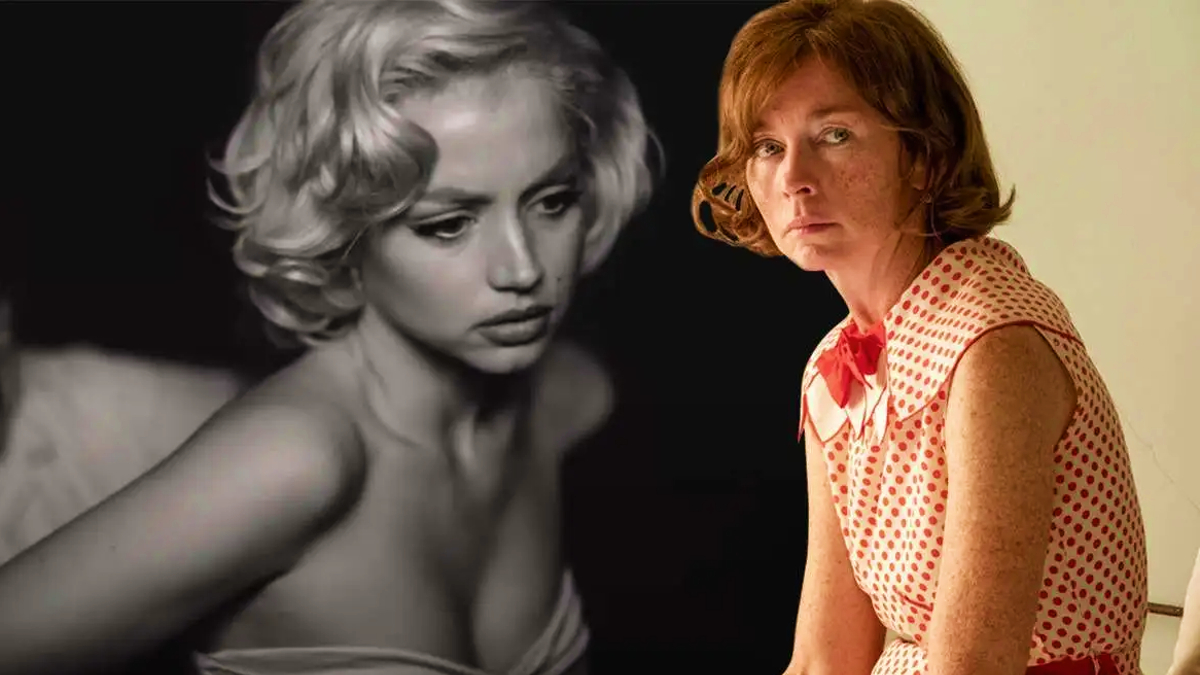
In the movie, Gladys Pearl Baker (Julianne Nicholson) epitomizes bad parenting, specializing in the area of neglecting and physically abusing her child. The very first sequence of the film depicts Norma Jean as a traumatic child who was forced to put up with her mother’s uncontrolled aggressions and erratic behavior.
In a short span of time, the movie’s Gladys indulged in terrifying actions like driving through a wildfire with her daughter wearing a nightgown only to be interrupted and saved by the cops, as well as attempting to drown little Norma Jean, who she blamed for her father breaking off the relationship with her. This culminated in Norma being taken in by a kind neighbor and eventually transferred to an orphanage. Gladys was later admitted to a state psychiatric facility only for Norma Marilyn to sporadically visit her.
In reality, Gladys was diagnosed with paranoid schizophrenia, unlike in the movie where she was diagnosed with a “mystery illness.” After that, she suffered a mental breakdown in 1934, in which she was then taken in by her mother’s close friend Grace Godard who became her legal guardian. However, she moved in with her aunt after getting molested by Godard’s husband.
Unlike the movie that shows her being born out of wedlock, Norma Jean was, in reality, the third child of Gladys and her abusive husband, John Newton Baker. The latter won the custodial battle for her other two children during their divorce in 1923. She was also briefly married to Martin Edward Mortenson, who is believed to be Marilyn’s real father.
Her engagement in a polyamorous relationship
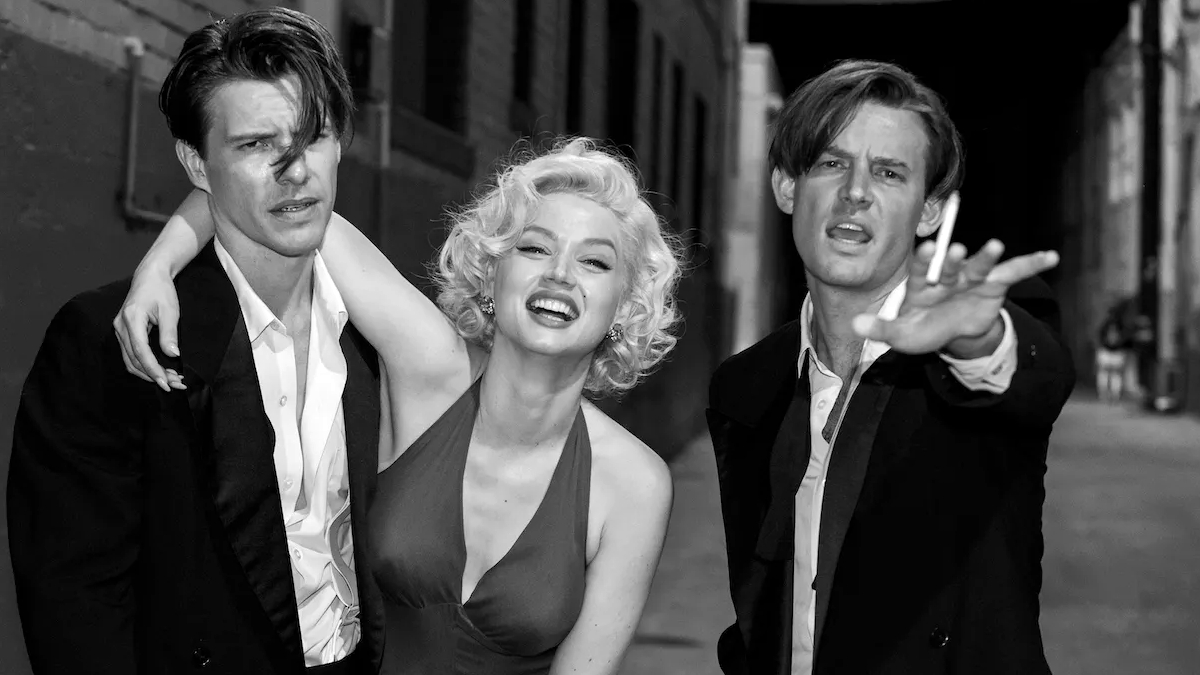
The movie shows Marilyn engaging in a three-way relationship with Cass Chaplin and Eddy Robinson Jr. at the L.A. Actor’s Circle in 1952. The three of them met at an apartment where they asked her to undress. All of them finally went on to have sex, which is how Monroe became part of a three-way relationship. However, the story doesn’t end there, as their relationship finally appeared as catnip for the tabloids, leading to lots of defaming and criticisms that were resultantly conferred on Monroe. However, things took a turn when she became pregnant with Cass’ child, but eventually got an abortion as she feared that her child would inherit her mother’s mental illness.
In reality, Marilyn’s affair with Cass and Eddy, or her involvement in any kind of polyamorous relationship, is not substantiated by any factual evidence. There have, however, been some discussions of a brief affair between Marilyn and Cass as per her biography Goddess: The Secrets Lives of Marilyn Monroe, written by Anthony Summers.
The book mentions Cass introducing Marilyn to her parents in 1947 when his father Charlie Chaplin Sr. became enamored by her. Cass mentions snippets of their interactions where he wrote, “Oh, she’s a beauty,’ Dad [Charlie Chaplin] used to tell me. ‘What a figure! I admire your taste, son, very much.'” Summer also states that Marilyn and Eddy, who met through Cass, dated for a while.
Their relationship was at its peak during the filming of Gentlemen Prefer Blondes when Marilyn was 27 and Cass was 19 years old. Although Summer’s biography shines some light on her relationship with both of them, there’s absolutely no evidence of the trio’s simultaneous dating.
Her abusive marriage with Joe DiMaggio
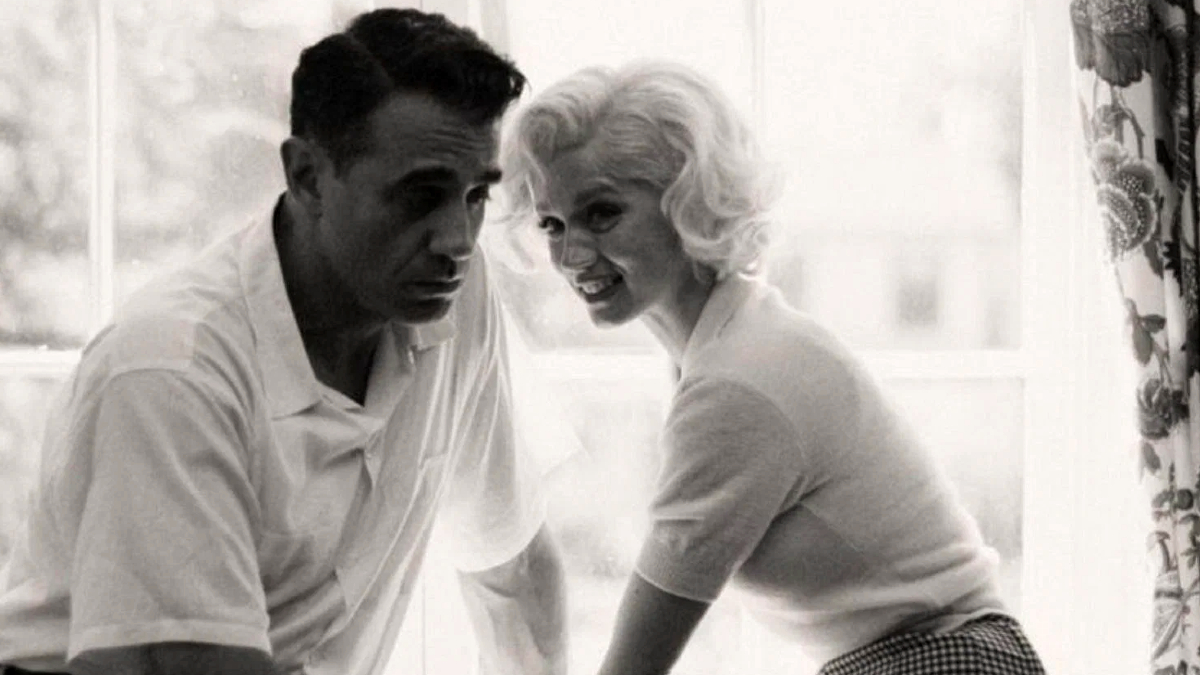
The movie depicts a fairy tale engagement scene between Marilyn and the popular baseball player Joe DiMaggio when Marilyn returned from her shoot one day to her hotel room hoping for her father to be waiting for her, only to discover America’s most loved athlete kneeling on one knee and proposing to her.
As romantic and briefly satisfying as this scene looks, especially for the audience, who by now have been eagerly waiting for anything good to happen in the actor’s life, the following sequence is filled with the domestic abuse and violence reflective of a toxic marriage. Before the proposal, Joe and Marilyn are shown to meet at a restaurant where the former was inquisitive about Marilyn’s success, mostly about how she had acquired fame.
It was only after her previous lover Cass shared her nude pictures with Joe that we get to see him physically abusing her and asking her to avoid the excessive spotlight. Things took an uglier turn when she appeared in the infamous dress-lifting scene in The Seven Year Itch that made ended in their divorce and a brief scene showing Joe inflicting physical assault on her.
The reality was quite similar along many lines. DiMaggio and Marilyn were indeed a celebrated couple whose marriage fell apart due to the former’s occasional outbursts at Marilyn. DiMaggio reportedly wanted a stay-at-home wife and wanted her to stay away from the fame and spotlight. Donald Spoto, in his 1993 biography, stated that DiMaggio was a “traditionalist” and an ardent advocate for conventional roles of women as housewives.
He wanted Marilyn to be subordinate and fulfill her wifely duties, which, in his eyes, don’t involve exceeding her husband in fame and popular recognition. The biography Joe and Marilyn: Legends in Love stated that his controlling behavior led him to strike her after he felt like his authority was being challenged.
The book mentions examples of how DiMaggio physically abused her when she failed to respond to his question in the manner he liked. This runs contrary to the movie’s portrayal of Cass as the villain who, by displaying Marilyn’s nude photos, was the key reason for the budding tensions in their marital relationship.
In fact, Marilyn confessed to her friend Brad Dexter about being in an unhappy marriage long before their divorce. As the film showed, the dress-lifting scene was the reason for their 9 months old relationship to come to an end. However, they remained close after their marriage until her death.
Was she sexually used by studio executives?
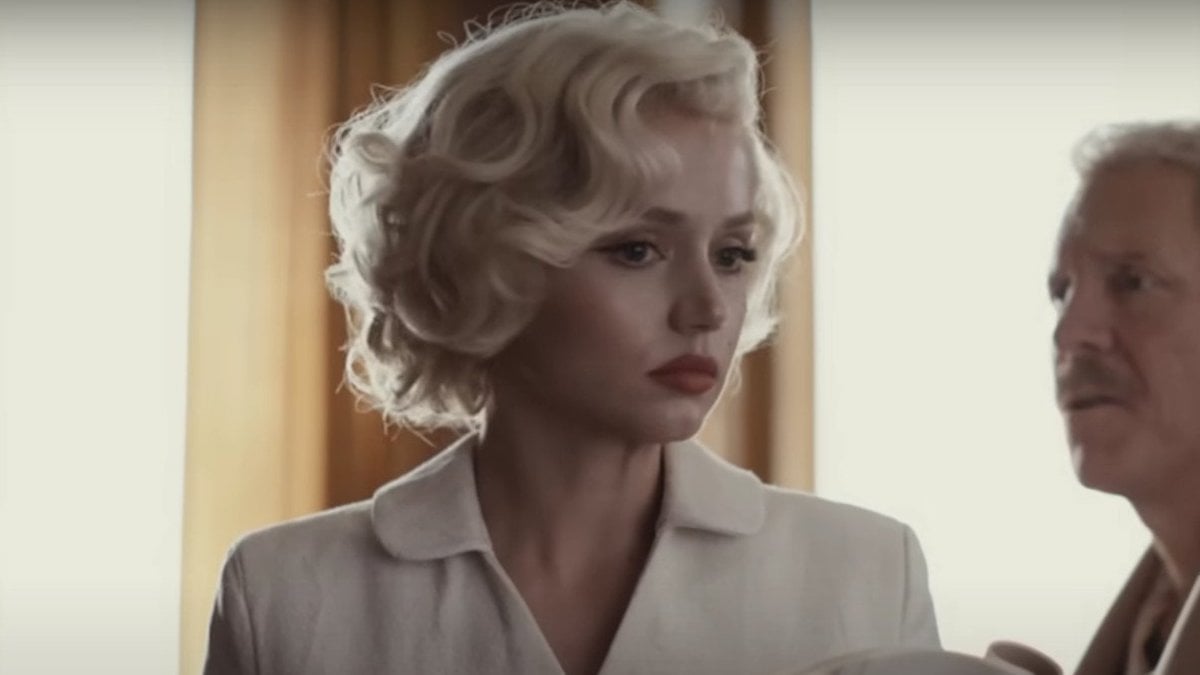
The film shows Marilyn approaching a certain Mr. Z, a studio head who played a vital role in giving her the first big break that catapulted her into Hollywood stardom and sensation. As an excited Marilyn approached to appear for her audition, to her shock, the producer made sexual advances and then went on to brutally assault her.
This is yet another scene that portrays her as a victim of the Industry’s debilitating methods to exploit aspiring female actors by making sexual advances on them and using it as their parameter for their future careers rather than focusing on their talents.
The identity of Mr. J Darryl is believed to be Darryl F. Zanuck, who, at the time, was the head of 20th Century Fox. Zanuck had a reputation for notoriously behaving with actresses so much so that The New York Times referred to it as “a well-documented habit of flashing his penis at women.”
Although Zanuck and Marilyn did not share the warmest of relationships (the former reportedly hated her), there is no mention of him ever having sexually abused Marilyn. Summer, in his biography, mentions that Marilyn did undergo various sex encounters with the casting couch but none of them mentions Zanuck or anyone that went by the name Mr. Z.
Interestingly, Marilyn entered into conflict with the Fox Studio after she refused to play the role of a dumb blonde by scrawling “TRASH” on the title page of the script that was given to her. This instigated Zanuck to file a lawsuit, which he later lost, forcing him to raise her salary to $100, 000.
Emboldened by this experience, Marilyn advanced to New York to start her own production company and co-produce movies like Bus Stop in 1956 and The Prince and the Showgirl in 1957. Her act of rebellion was completely omitted from the movie and not much was focused on her tiff with the eminent executives of the Industry.
Her relationship with John F. Kennedy
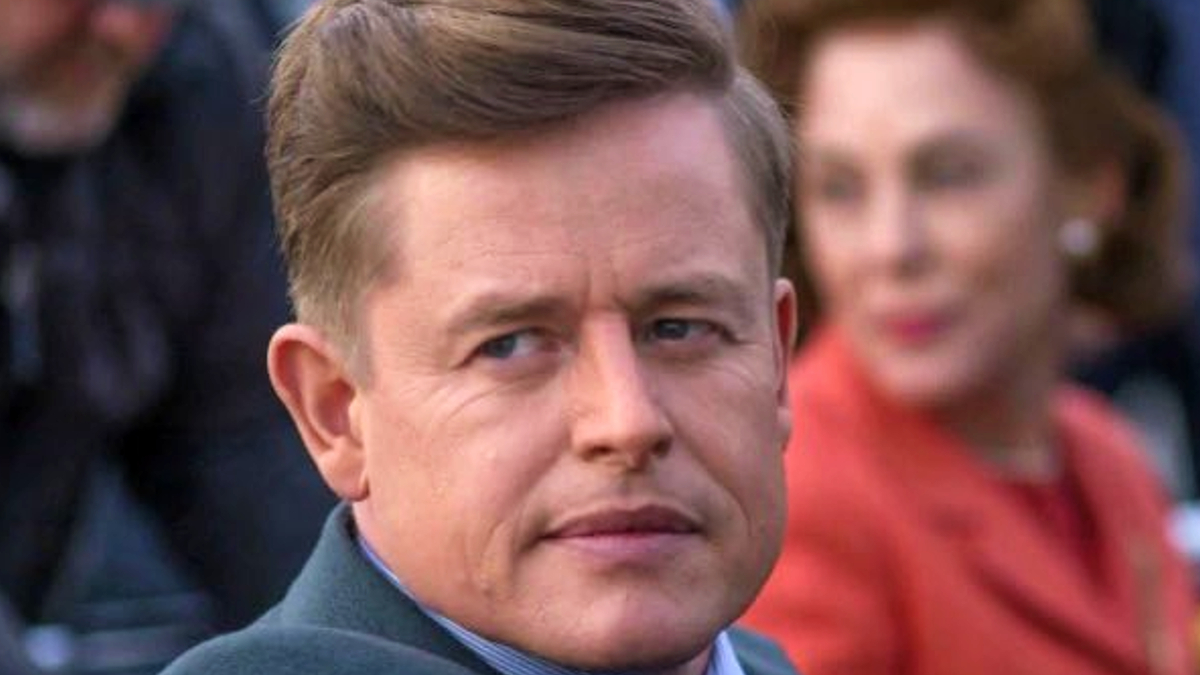
Hollywood is known for numerous scandalous events and romances, but none of them hold a candle next to the most talked about affair to date, the accuracy of which is still uncertain. Of course, that relationship is between Marilyn Monroe and U.S. President John F. Kennedy.
Their infamous interaction is depicted in the movie’s last sequence when Marilyn was trafficked to Kennedy (Caspar Phillipson) by his secret service agents. She speaks on the subject of her relations with the President in the car where she says, “It isn’t sexual between the President and me. It has very little to do with sex. It’s a meeting of our souls.”
After taking her to a hotel room, where Kennedy barely acknowledges her presence, she was forced to perform fellatio, after which he raped her to unleash his frustrations about the sexual allegations that were being made against him. The scene then cuts to her lying on the bed in a depressive state, and there is no further mention of Marilyn and Kennedy’s interactions.
Kennedy and Marilyn’s relationship was subjected to numerous speculations, but concrete evidence about their sexual affairs could never be gathered. Even the date of their exact meeting is not clear. According to biographer James Spada, they met through Kennedy’s brother-in-law Peter Lawford. Even though there is evidence of them socializing on various occasions, they were accompanied by other people and were never spotted alone.
The only event that hinted at this scandalous affair is her singing “Happy Birthday” while wearing a skin-tight white gown on the occasion of Kennedy’s birthday in 1962. This escalated the rumors about a potential affair between the two of them that is not backed by any actual evidence. Given the positions that they held and their popularity, it is difficult to fact-check the existence of a relationship between them.
Blonde is currently available to stream on Netflix.











Published: Oct 4, 2022 07:59 am